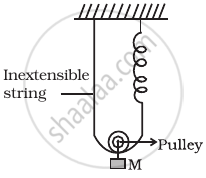Advertisements
Advertisements
Question
A spring having with a spring constant 1200 N m–1 is mounted on a horizontal table as shown in Fig. A mass of 3 kg is attached to the free end of the spring. The mass is then pulled sideways to a distance of 2.0 cm and released.

Determine (i) the frequency of oscillations, (ii) maximum acceleration of the mass, and (iii) the maximum speed of the mass.
Solution 1
Spring constant, k = 1200 N m–1
Mass, m = 3 kg
Displacement, A = 2.0 cm = 0.02 cm
(i) Frequency of oscillation v, is given by the relation:
`v = 1/T = 1/(2pi) sqrt(k/m)`
Where, T is the time period
`:. v = 1/(2xx3.14) sqrt(1200/3) = 3.18 "m/s"`
Hence, the frequency of oscillations is 3.18 cycles per second.
ii) Maximum acceleration (a) is given by the relation:
a = ω2 A
Where
ω = Angular frequency = `sqrt(k/m)`
A = Maximum displacement
`:. a = k/m A = (1200xx0.02)/(3) = 8 ms^(-2)`
Hence, the maximum acceleration of the mass is 8.0 m/s2
iii) Maximum velocity, vmax = Aω
`= A sqrt(k/m) = 0.02 xx sqrt(1200/3) = 0.4 "m/s"`
Hence, the maximum velocity of the mass is 0.4 m/s.
Solution 2
K = 1200 `Mn^(-1)`; m = 3.0 kg, a= 2.0 cm = 0.02 m
i) Frequency, `v = 1/T = 1/(2pi) sqrt(k/m) = 1/(2xx3.14) sqrt(1200/3) = 3.2 s^(-1)`
ii) Acceleration, A = `omega^2` `" " y = k/m y`
Acceleration will be maximum when y is maximum i.e y = q
:. max acceleration,` A_"max" = (ka)/m =(1200xx0.02)/3 = 8 ms^(-2)`
iii) Max speed of the mass will be when it is passing throught mean position
`V_"max" = aomega = sqrt(k/m) = 0.02 xx sqrt(1200/3) = 0.4 ms^(-1)`
APPEARS IN
RELATED QUESTIONS
When the length of a simple pendulum is decreased by 20 cm, the period changes by 10%. Find the original length of the pendulum.
The phase difference between displacement and acceleration of a particle performing S.H.M. is _______.
(A) `pi/2rad`
(B) π rad
(C) 2π rad
(D)`(3pi)/2rad`
The acceleration due to gravity on the surface of moon is 1.7 ms–2. What is the time period of a simple pendulum on the surface of moon if its time period on the surface of earth is 3.5 s? (g on the surface of earth is 9.8 ms–2)
The relation between acceleration and displacement of four particles are given below: Which one of the particles is executing simple harmonic motion?
Which of the following statements is/are true for a simple harmonic oscillator?
- Force acting is directly proportional to displacement from the mean position and opposite to it.
- Motion is periodic.
- Acceleration of the oscillator is constant.
- The velocity is periodic.
When will the motion of a simple pendulum be simple harmonic?
Find the time period of mass M when displaced from its equilibrium position and then released for the system shown in figure.

A body of mass m is situated in a potential field U(x) = U0 (1 – cos αx) when U0 and α are constants. Find the time period of small oscillations.
Consider a pair of identical pendulums, which oscillate with equal amplitude independently such that when one pendulum is at its extreme position making an angle of 2° to the right with the vertical, the other pendulum makes an angle of 1° to the left of the vertical. What is the phase difference between the pendulums?
A cylindrical log of wood of height h and area of cross-section A floats in water. It is pressed and then released. Show that the log would execute S.H.M. with a time period. `T = 2πsqrt(m/(Apg))` where m is mass of the body and ρ is density of the liquid.
